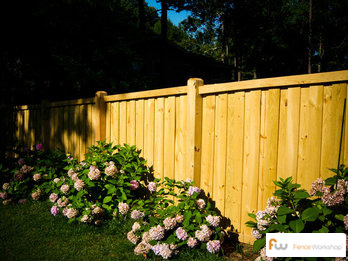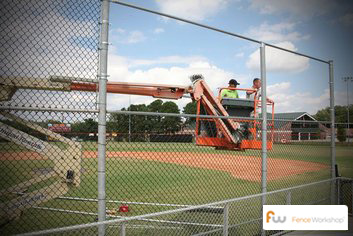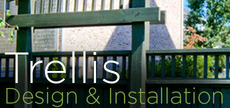Landscaping
Landscaping & Your Fence: A Symbiotic Relationship
Landscaping Your New Custom Built Fence Workshop™ Fence:
At Fence Workshop™, we think adding landscaping to one of our custom built fences can drastically increase the beauty of any outdoor living space. Landscaping can also be used to further increase the privacy provided by one of our wood privacy fences, or even chain link fences with privacy slats installed. Landscaping, when done right, appeals to all the senses and assists in visually defining the perimeter of your property.

How To Get the Most out of Your Landscape:
Our fences, when paired with great landscaping, add long-lasting beauty and can add style to the plain base of a fence. Commonly, our customers use landscaping near fences as a way to hide or minimize the negative space created when building some larger fences. The most important functions of fence landscaping are to add beauty and style, take advantage of an otherwise underused planting space, or attract birds and beneficial insects to your property. Create the greatest visual impact in the shortest time by planting mature plants, or reduce upfront costs by planting younger plants, which will also give you more time to enjoy the nurturing aspect of gardening. And if you need any help, we’re here for you. We work with experts in the industry and can assist you in any landscaping decisions made for your property.

A Few More Details:
Another point to remember when planning fence landscaping with our expert staff is to give young plants enough room to grow unimpeded by the fence. If this is not considered early on, be prepared to transplant them as they mature. Also, choose plants whose roots will not undermine the fence’s foundation over the years. If we’re adding to an existing fence on your property you could give an older fence new life by creating a unique rustic design that complements the condition of the fence. Turn older planks of wood into neat focal points by adding lavender or viburnum. Landscaping for a fence can inexpensively add year-round beauty to your property.
Something You May Not Have Considered:
A fence can create what is called a “microclimate” in the area next to it by blocking winds and raising temperatures. Make the most of this benefit by using plants that may not grow as well in other parts of your property. Add to the fragrances of flowers by planting them alongside tall, solid fences that prevent the aroma from dissipating as quickly as they would in a more open area. Low-growing plants add bright borders to backyard fences. Use our white vinyl or painted wood privacy fences as backdrops to highlight colorful flowers and foliage on your property. See details on flowers more easily by placing them in front of a plain fence. White or light-colored fences will reflect more light on plants, helping the plants to develop evenly, thus increasing your fence landscaping’s beauty even more.


Chain Link and Plants: The Facts
Another fence type to consider is chain-link fencing. Chain Link fences from Fence Workshop™ are built with quality gauge wire, are open, and provide excellent support for climbing vines such as Clematis paniculata, commonly known as Sweet Autumn Clematis, and Ipomoea alba, commonly known as moonflowers. Let low-growing plants accent a fence, and in particular, those fences with decorative tops. Bright bursts of color from flowers such as marigolds can anchor a fence and make it more visually appealing. Put plants into containers and add them to places where in-ground planting is not feasible. Container planting increases flexibility by making it easier to swap plants at shorter intervals without having to dig in the ground. Containers can add color, pattern and depth to an otherwise flat area near your fence.


Care and Consideration:
Finally, watering plants near a fence can be tricky. Protect the fence and try to water only the plants and not the fence. Exercise caution when watering with a hose and direct automatic sprinklers to reach the plants but not as far as the fence. Large plants with full foliage will reduce the amount of air circulating around the fence and will block direct sunlight, which raises the chance of fungus on wood fences or mold on vinyl fences. Fence Workshop™ can add sealants and make repairs on fences before delicate flowers or winding branches start to limit access to the fence.


Consideration For Your Neighbors:
As a rule: Do not plant invasive species on fence lines marking a neighbor’s border without permission. Plants do not respect property deeds. Hedera helix, commonly known as English Ivy, is a prime example of a plant landscapers should avoid because of its aggressive growing habit. English Ivy will spread over, under and through fences. Avoid creating attractive nuisances along any perimeter fences. Steer clear of plants that produce inviting but poisonous berries where children are likely to pass your property. Similarly, avoid pretty but prickly plants in those same areas.
Get Started – Shop Our Fences Now!
We know you’re getting excited about your new fencing project, and we would love to help. You’re just a call or click away from getting started! Our passion is the art of beautiful fences, and we can’t wait to share that passion with you to create the dazzling fencing you’ve been dreaming of. Get started now!
Phone: (404) 973-2911 Email: [email protected] Get a quote: Online Quick Quote Form

 Go Back
Go Back





















